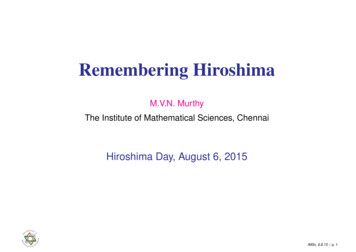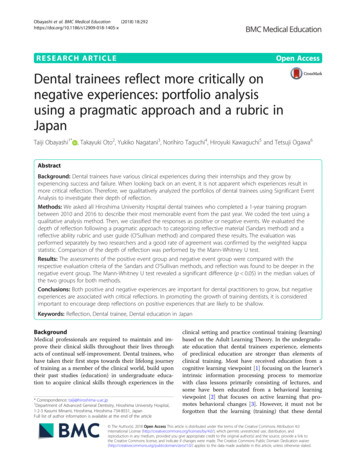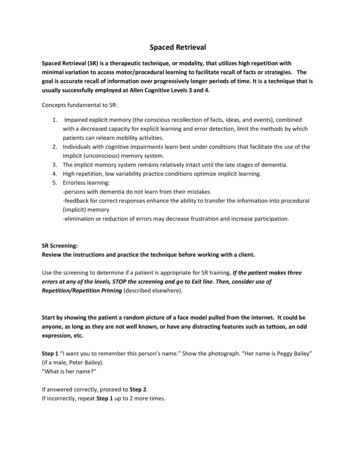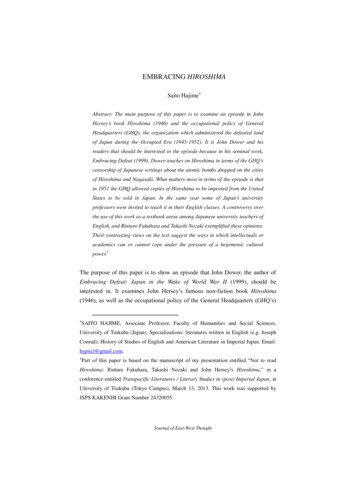
Transcription
Remembering HiroshimaM.V.N. MurthyThe Institute of Mathematical Sciences, ChennaiHiroshima Day, August 6, 2015IMSc, 6.8.15 – p. 1
References1. http://www.dannen.com/decision/ - Atomic Bomb: Decision - containsthe original, now declassified, documents on the decision to useatomic bombs on the cities of Hiroshima and Nagasaki.2. http://www.dannen.com/szilard.html/ - The Leo Szilard page, whichnot only contains various reports of the time, but also has details onthe role played by Leo Szilard and other scientists.3. http://www.peak.org/d̃anneng/decision/usnews.html - Authorisedweb-reprint of the full text of the Leo Szilard interview, “PresidentTruman did not understand".4. http:/www.doug-long.com - Hiroshima: Was it necessary? A personalexploration of morality and WW-II military history. An excellentanalysis of the events in 1945.IMSc, 6.8.15 – p. 2
The BookTHE TRAGEDY OFHIROSHIMA AND NAGASAKICompiled and Edited byD. Indumathi, M. V. N. Murthy and R. ShankarPublished forIndian S ientists Against Nu lear WeaponsbyTamil Nadu S ien e ForumNovember 2000IMSc, 6.8.15 – p. 3
Hiroshima -1945August 6, 1945: 1,40,000 DEADIMSc, 6.8.15 – p. 4
Nagasaki -1945August 9, 1945: 90,000 DEADIMSc, 6.8.15 – p. 5
“A bright light filled the plane," wrote Lt. Col.a Paul Tibbets, the pilot of theEnola Gay, the B-29 that dropped the first atomic bomb. “We turned backto look at Hiroshima. The city was hidden by that awful cloud.boiling up,mushrooming." For a moment, no one spoke. Then everyone was talking.“Look at that! Look at that! Look at that!" exclaimed the co-pilot, RobertLewis, pounding on Tibbets’s shoulder. Lewis said he could taste atomicfission; it tasted like lead. Then Lewis turned away to write in hisjournal. “My God," he asked himself, “what have we done?"aPaul Tibbets was Colonel, not Lt. Colonel, when he was the pilot of the Enola Gay.IMSc, 6.8.15 – p. 6
OutlineNature of war changed with the birth of Weapons of MassDestruction (WMD), unleashing the most destructive power ofscience and technology.After the Manhattan Project which gave birth to WMD, therelationship between Physics, Physicists (in particular andscientists in general), Military and Politics changed for ever(*).This talk traces the events that lead to the development of WMD,selection of the targets, how the decision was made and the actualbombing.(*)“After the war, the physicists were oftern asked to . give advice to varioussections of the government especially the military. the military felt we were usefulfor something”—FeynmanIMSc, 6.8.15 – p. 7
In a nutshellIn the words of Mr. Kosuke Shishido, one of the “Hibakusha” orsurvivors of the bomb attack on Hiroshima,“I personally do not blame the USA. It was a war. Japan might have done a similarthing in a different situation. However, I believe it was a sin to kill so many peopleinstantly. On the basis of my research, I have concluded . There was a group ofpeople (military people and scientists) who wanted to experiment with the bombthat they had developed. Some high level people in the government wanted toshow the world the military power of the country (in the sense of using A-bombpolitically). Some people who played a significant role in the development of thefirst A-bomb in history wanted to kill as many people as possible to get even withJapan for Pearl Harbour and the Phillipines war. The project that developed thefirst two A-bombs had spent a significant amount of money and they needed ajustification .”IMSc, 6.8.15 – p. 8
A Time line1938 Fission of Uranium- unleashing the power of nucleus(Hahn, Meitner, Strassmann)1939 August 2nd, Letter to President Roosevelt (Einstein)1942 September, Manhattan project begins with Oppenheimeras its scientific director.1942 December, The first controlled nuclear reactor is built atthe University of Chicago by Fermi and collaborators.1945 May 8, Germany surrenders, end of war in Europe.1945 July 16, The Trinity Test in New Mexico desert.1945 August 6 and 9, bombing of Hiroshima and NagasakiIMSc, 6.8.15 – p. 9
The beginningIn the summer of 1939, six months after the discovery of uranium fissionby German scientists, its military use was a possibility. Leo Szilard wasprofoundly disturbed by the possibility that Nazi Germany might makeatomic bombs, leading to disastrous consequences for the rest of theworld. Szilard turned to Albert Einstein for help.Einstein agreed to write the letter to the President on 2nd August 1939.He urged the President to start work by a group of physicists on chainreactions which may be used to construct extremely powerful bombs of anew type.Einstein was a life-long pacifist, nevertheless the sole possession of theatomic bomb by the Nazis with its destructive power allowed him tosupport efforts by Szilard and share his fears.(*)(*)Later he regretted his decision and says “ had I known the fear was not justified I wouldnot have participated in the opening of this Pandora’s box.”IMSc, 6.8.15 – p. 10
Einstein’s letter- excerptsAugust 2, 1939: Some recent work by E. Fermi and L. Szilard, which hasbeen communicated to me in manuscript, leads me to expect that theelement uranium may be turned into a new and important source ofenergy in the immediate future. Certain aspects of the situation which hasarisen seem to call for watchfulness and, if necessary, quick action on thepart of the Administration. I believe therefore that it is my duty to bring toyour attention the following facts and recommendations:.This new phenomenon would also lead to the construction of bombs,and it is conceivable- though much less certain- that extremely powerfulbombs of a new type may thus be constructed. A single bomb of this type,carried by boat and exploded in a port, might very well destroy the wholeport together with some of the surrounding territory. However. suchbombs might very well prove to be too heavy for transportation by air. I understand that Germany has actually stopped the sale of uraniumfrom the Czechoslovakian mines which she has taken over. .IMSc, 6.8.15 – p. 11
Manhattan ProjectOfficial skepticism stalled the proposal until after the bombing of PearlHarbour in December 1941.The Manhattan project, name given to the atomic bomb project,officially began in August 1942.By the beginning of 1945, the atomic bomb was a reality and the workwas in full swing for actual testing of the bomb. The details of thiseffort is well documented —Richard Rhodes, The making of the atomic bomb.Germany surrendered in May 1945 ending the war in Europe. Theoriginal motivation, the fear of Nazis getting hold of the bomb,evaporated.The focus shifted to Pacific where Japan was still at war with theallies, while seeking an honourable way out for surrenderIn early May 1945 a target selection committee was formed.IMSc, 6.8.15 – p. 12
Project LeadersScientific and Military leaders of the project: Dr RobertOppenheimer and General Leslie Groves.IMSc, 6.8.15 – p. 13
Target Committee ReportExcerpts from the meeting held on 10-11 May 1945: Summary of Target,Memorandum for General Groves.1. The second meeting of the Target Committee convened at 9:00 AM 10May in Dr. Oppenheimer’s office at Site Y with the following present:General Farrell, Dr. C. Lauritsen, Colonel Seeman, Dr. Ramsey, CaptainParson, Dr. Dennison, Major Derry, Dr. von Neumann, Dr. Stearns, Dr.Wilson, Dr. Tolman, Dr. Penne, Dr. Oppenheimer.Dr. Bethe and Dr. Brode were brought into the meeting for discussion ofItem A of the agenda. .The concluding meeting was held at 10:00 AM 11May in Dr. Oppenheimer’s office with the following present:Colonel Seeman, Dr. Stearns, Captain Parsons, Dr. Von Neumann, MajorDerry, Dr. Dennison, Dr. Tolman, Dr. Penney, Dr. Oppenheimer, Dr.Ramsey, Dr. Wilson. The agenda presented by Dr. Oppenheimer consisted of thefollowing. height of detonation, weather., psychological factors,.use against militaryobjectives,. etc.IMSc, 6.8.15 – p. 14
Selection criterionStatus of Targets (Excerpted from the document produced by the targetcommittee):Dr. Stearns described the work he had done on target selection. He hassurveyed possible targets possessing the following qualification:they be important targets in a large urban area of more than threemiles in diameter,they be capable of being damaged effectively by a blast, andthey are unlikely to be attacked by next August.Dr. Stearns had a list of five targets which the Air Force would be willing toreserve for our use unless unforeseen circumstances arise.IMSc, 6.8.15 – p. 15
Recommended Targets- excerptsKyoto - This target is an urban industrial area with a population of1,000,000. From the psychological point of view there is theadvantage that Kyoto is an intellectual center for Japan and thepeople there are more apt to appreciate the significance .weapon .Hiroshima - This is an important army depot and port of embarkationin the middle of an urban industrial area.and it is such a size that alarge part of the city could be extensively damaged. There areadjacent hills which are likely to produce a focussing effect whichwould considerably increase the blast damage.Yokohama (Urban Industrial).- Kokura Arsenal. - Niigata (Port) .Emperor’s palace!. were also discussed.recommendation of those present .that the first four choices oftargets.:a. Kyoto b. Hiroshima c. Yokohama d. Kokura Arsenal (No mentionof Nagasaki!)Dr Stearns . to request reservation of these targets (from the military).IMSc, 6.8.15 – p. 16
Objectives - excerptsA. It was agreed that psychological factors in the target selection were ofgreat importance. Two aspects of this are (1) obtaining the greatestpsychological effect against Japan and (2) making the initial usesufficiently spectacular for the importance of the weapon to beinternationally recognised when publicity on it is released.B. In this respect Kyoto has the advantage of the people being morehighly intelligent and hence better able to appreciate the significance ofthe weapon. Hiroshima has the advantage of being such a size and withpossible focussing from nearby mountains that a large fraction of the citymay be destroyed. The Emperor’s palace in Tokyo has a greater famethan any other target but is of least strategic value.A. Use against “Military objective": It was agreed that for the initial use ofthe weapon any small and strictly military objective should be located in amuch larger area subject to blast damage in order to avoid undue risks ofthe weapon being lost due to bad placing of the bomb.IMSc, 6.8.15 – p. 17
The Franck ReportScientists, in other labs, were beginning to worry about the consequencesof its use.The Franck Report, written by a seven-man (*) panel of scientists at theUniversity of Chicago, urged that the bomb be demonstrated before theeyes of representatives of all United Nations, on a desert or a barrenisland.The report is long, detailed and addresses extremely complex andimportant questions. In many ways the pronouncement of the memberswas prophetic if one looks back at the last fifty years of the atomic age–(cannot remain secret, .long term policy must over-ride militaryexpediency, .towards agreement for effective international control.)(*) James Franck (Chair), Donald J Hughes, JJ Nickson, Eugene Rabinowitch, Glen TSeaborg, J C Stearns, Leo Szilard. Rabinowitch drafted the reportIMSc, 6.8.15 – p. 18
Accident of HistoryJames Franck and Glenn Seaborg.The committee was appointed by Compton met in secret in all nightsessions in secret locations. Manhattan Project authorities were sooutraged by this report that some sentences in all copies, including theoriginal in the National Archives, were permanently censored with ink. .“By an accident of history, we were among a very few who were aware ofa new, world-threatening peril, and we felt obligated to express ourviews."– Glenn T. SeaborgIMSc, 6.8.15 – p. 19
No acceptable alternative?Despite the Franck report and arguments made against the bomb, ascientific panel found no acceptable alternative:Recommendations on the Immediate Use of Nuclear Weapons, by theScientific Panel of the Interim Committee on Nuclear PowerA. H. Compton, E. O. Lawrence, J. R. Oppenheimer, E. Fermi(signature) J. R. Oppenheimer, For the PanelJune 16, 1945You have asked us to comment on the initial use of the new weapon. Thisuse, in our opinion, should be such as to promote a satisfactoryadjustment of our international relations. At the same time, we recogniseour obligation to our nation to use the weapons to help save Americanlives in the Japanese war (*).(*)Initial military estimates of the American casualities was around 40,000-60,000 in a fullscale invasion. After the war exagerrated figures like 300,000 to 500,000 appeared inpost-facto justification of the bombing.IMSc, 6.8.15 – p. 20
No acceptable alternative?- excerptsTo accomplish these ends we recommend that before the weaponsare used not only Britain, but also Russia, France, and China beadvised. .these(bombs) may be ready to use during the presentwar.The opinions of our scientific colleagues on the initial use of theseweapons are not unanimous. purely technical demonstration to thatof the military application best designed to induce surrender.findourselves closer to these latter views. .we see no acceptablealternative to direct military use.With regard to these general aspects of the use of atomic energy, it isclear that we, as scientific men, have no proprietary rights. .noclaim to special competence in solving the political, social, andmilitary problems which are presented by the advent of atomic power.IMSc, 6.8.15 – p. 21
But there was more opposition!Ralph A Bard- Undersecretary of the Navy: says that given theposition of US as a humanitarian nation and fair play attitude, Japanshould be given a warning before actual use.However, he feels that Japan may be searching for opportunity forsurrender with an assurance on the status of the Emperor of Japan(June 1945)Szilard petition signed by 58 other scientists to the President makesthe point that the danger has been averted.(July 1945) (the dangerof an atomic bomb attack by Germany having lost the war.)The Oak Ridge petition signed by 67 members realise the specialmoral obligation on them, urges demonstration. (mid July 1945).IMSc, 6.8.15 – p. 22
“I have become death ."The Trinity Test:The successful test of the bomb took place on July 16 1945. In a dairyentry President Truman says: This weapon is to be used against Japanbetween now and August 10th. .use it so that military objectives andsoldiers and sailors are the target and not women and children. Even ifthe Japs are savages, ruthless, merciless and fanatic, we as the leader ofthe world for the common welfare cannot drop the bomb that terrible onthe old capital or new. .“I have become death, the shatterer of the worlds" Robert OppenheimerIMSc, 6.8.15 – p. 23
Surrender aborted?Intercepted cables around July 12-13 showed Japan’s Emperor hadintervened to end the war.An intercepted message from Foreign Minister Togo to Ambassador Satoin Moscow said“The fact that the Americans alluded to the Atlantic Charter is particularlyworthy of attention at this time. It is impossible for us to acceptunconditional surrender, no matter in what guise, but it is our idea toinform them by some appropriate means that there is no objection to therestoration of peace on the basis of the Atlantic Charter."(*)(*) Atlantic Charter was the declaration of peace aims by Roosevelt andChurchill on August 14, 1941. “respect the right of all peoples to choosethe form of government under which they live . ". This would haveallowed Japan to keep the status of the Emperor intact. While this wasignored at this time, the status of the Emperor was allowed to remainintact even after the Bombing of Hiroshima and Nagasaki.IMSc, 6.8.15 – p. 24
Powerplay at PotsdamJuly 17-Aug.2: The goals of Potsdam conference included the post-warorder, peace treaty issues, and countering the effects of the war.President Truman delayed the conference to be sure of the Trinity test in the hope that itwill enhance the bargaining power. On July 24, 1945 in conversation with Stalin, thePresident informed him that the United States had successfully detonated the first atomicbomb on July 16, 1945. Apparently Stalin already knew from the intelligence network. Theattempt was to keep Stalin out Japan’s surrender. The Powerplay at Potsdam marks thebeginning of the Cold War.IMSc, 6.8.15 – p. 25
The bombingActing Chief of Staff General Handy gave the orders for bombing tothe Air Force General Carl Spaatz after about 3 August 1945 as soonas weather permits. “ personnel from the War Department to observeand record effects of the explosion of the bomb.additional bombs willbe delivered . as soon as made ready by project staff."The actual bombing took place on Hiroshima on 6 August, followed byNagasaki on the 9th. There is no satisfactory explanation for thebombing of Nagasaki- it was not one of the original targets.Truman in his radio address after the bombing on the 9th said“.The world will note that the first atomic bomb was dropped onHiroshima, a military base. .we wished to avoid in this first attack toavoid, insofar as possible, the killing of civilians. attack is only awarning of things to come.". Was he misinformed or did he notunderstand!IMSc, 6.8.15 – p. 26
Later RecollectionsWhat did the Military (outside the secret Manhattan project)? Asdocumented in the interviews, dairies etc we haveAdmiral Willian D Leahy (Chief of Staff to President)- “The use of thisbarbarous weapon at Hiroshima and Nagasaki was no materialassistance in our war against Japan. The Japanese were alreadydefeated and ready to surrender."The commanding general of US Army-Air Forces: Henry H Arnold–“The Japanese position was hopeless even before the first atomicbomb fell."General Carl Spaatz- Commander of US Army Strategic Air Force– “Ithought that if we were going to drop the atomic bomb drop it on theoutskirts- say in Tokyo Bay.made this suggestion over phone." Heinsisted on receiving written orders before going forward—commentedthat the decision was purely political and not a military one.General MacArthur thought it was a tragedy., In his memoirsEisenhower says that the dropping was “completely unnecessary.nolonger mandatory as a measure to save American lives."IMSc, 6.8.15 – p. 27
Final WordThis talk began with Szilard prodding of Einstein to write the letter to thePresident Roosevelt. We give him the final word:“Suppose Germany had developed two bombs before we had any bombs.And suppose Germany had dropped one bomb, say, on Rochester andthe other on Buffalo, and then having run out of bombs she would havelost the war. Can anyone doubt that we would then have defined thedropping of atomic bombs on cities as a war crime.governments acting ina crisis are guided by questions of expediency, and moral considerationsare given very little weight,.Truman did not understand"IMSc, 6.8.15 – p. 28
IMSc, 6.8.15 – p. 29
By the beginning of 1945, the atomic bomb was a reality and the work was in full swing for actual testing of the bomb. The details of this effort is well documented — Richard Rhodes, The making of the atomic bomb. Germany surrendered in May 1945 ending the war in Europe. The original motivation, the fear of Nazis getting hold of the bomb .










